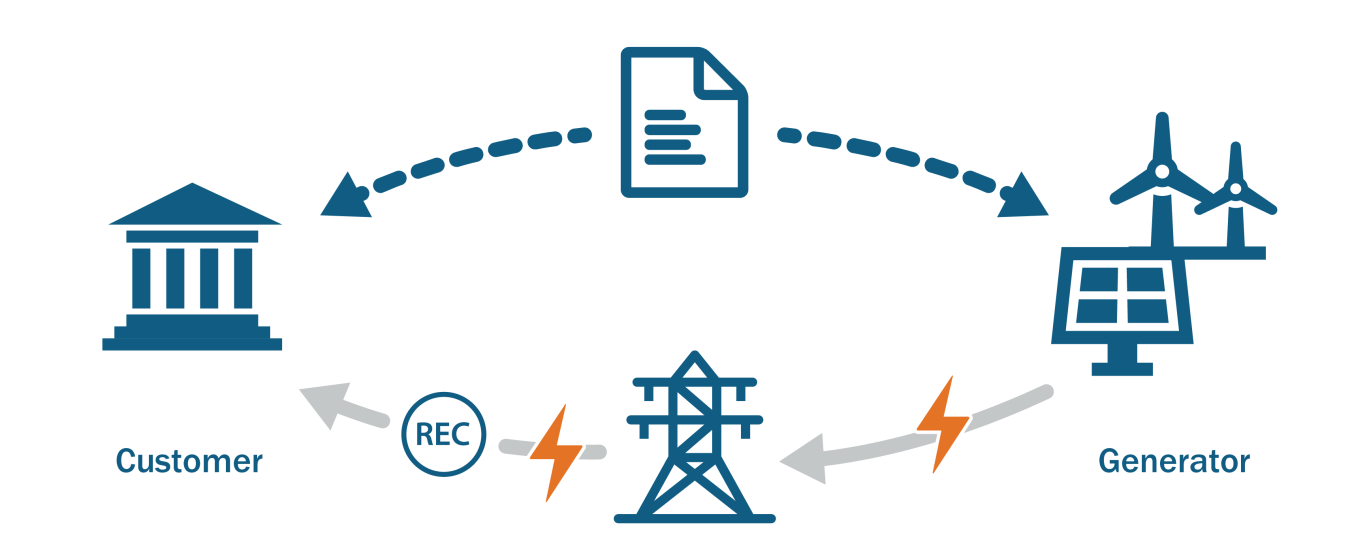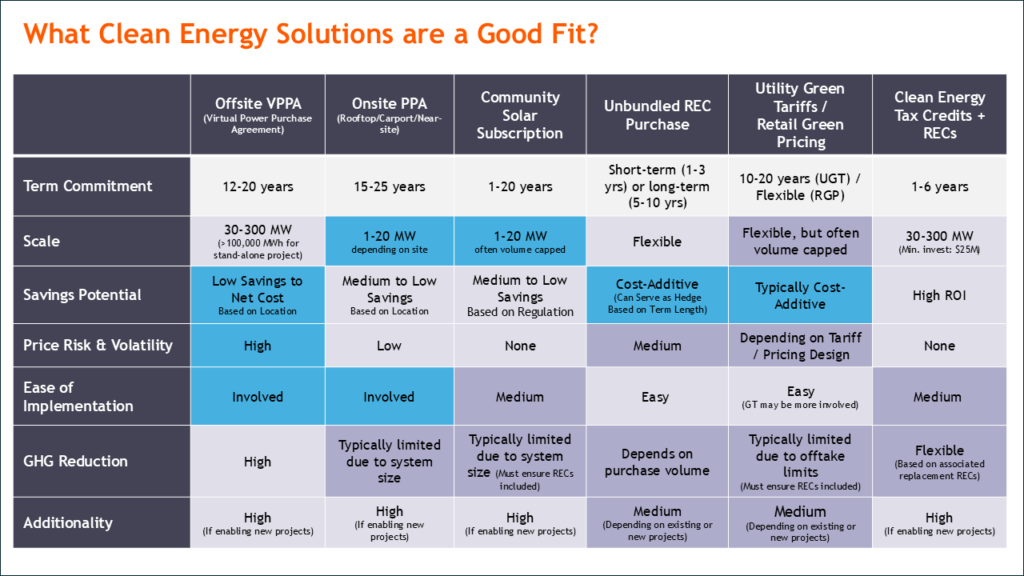
In our Powering Up blog series, experts from across the MN8 Energy team share insights to help you better understand clean energy procurement, fleet electrification and sustainability initiatives. In this post, we’ll break down the key pathways for procuring clean energy, how they differ and how those in energy and sustainability roles should be thinking about utilizing them.
For sustainability practitioners and energy managers alike, energy procurement rarely feels like the most straightforward topic. And suddenly, you’re at a sustainability conference, realizing how early your company is in its net-zero journey compared to its peers, that it needs to make real progress on clean energy procurement, and you’re not quite sure what’s the right path forward.
That’s where MN8 Head of Energy Management and Trading Tyler Anthony stepped in earlier this year at the GreenBiz 25 conference during a session on the topic, and offered a clear and approachable breakdown of how businesses can start making smart, strategic clean energy decisions—no matter where they are on the learning curve. To help others with their journey, we’re sharing that breakdown here.
Choosing How to Procure Isn’t a One-Path-Fits-All Proposition
Fundamentally, organizations can take various paths to procure clean energy—from quick wins to more complex, high-impact solutions—each with different advantages and tradeoffs. The key is to focus on what specifics work for you and your company’s needs. Just getting started – setting goals and getting your first purchases underway – is an achievement. As you progress, the focus must be on what’s right for your organization and meeting its goals.
The chart below provides an at-a-glance view of how the level of effort, impact and complexity changes as you move across the spectrum of options. Further, key attributes and benefits are included in the first column, to give you a quick way to explore how different impacts come into play for each before diving too deeply. You can then look at how each aligns with your organization’s internal goals or initiatives, and expand strategy from there.
 (Click to download a larger version in PDF)
(Click to download a larger version in PDF)
Exploring the Options: Clean Energy Procurement Pathways
First, let’s look at the low hanging fruit options.
Utility green tariffs or retail green power purchasing are often the first and easiest step into clean energy procurement. Organizations opt in through their utility’s green energy programs, which are reflected directly on their utility bill.
These programs are often easy to implement – they can be as simple as signing up online and choosing an option based on contract duration and pricing – but your ability to take part in these programs may be limited by availability or the scale of your organization’s electricity consumption. In addition, both may represent additional costs beyond your typical utility bill for sourcing renewable energy certificates (RECs) or securing clean energy matched from the utility’s portfolio.
Unbundled REC purchases are another starting point, providing simplicity and flexibility. Organizations can buy unbundled RECs through brokers or suppliers and choose from regional or national sources. While not tied to physical energy delivery, these RECs allow organizations to claim the environmental benefits of renewable energy generated elsewhere, offsetting emissions from electricity consumed where they operate. These can be purchased directly from a supplier or through a REC broker.
This approach is low-complexity and offers short contract terms (1–5 years), which offers flexibility for organizations that are developing or evolving their approach. Pricing for RECs varies based on geography, certification by specific groups for specific attributes (for example, additionality or emissionality), and market conditions. Your organization’s choices depend on which impacts you would eventually like to claim.
The next step up in complexity is moving to bilateral agreements – contracts signed with a specific party to procure clean energy from a single source or multiple sources.
Community solar subscriptions are an option growing in popularity, because they allow an organization to support local clean energy generation, particularly helpful when they can’t build onsite, as with leased facilities, and can offer potential savings over utility rates.
Under this type of arrangement, customers subscribe to a portion of a local solar project in their utility territory. An organization’s ability to subscribe depends on factors like zip code, size, and creditworthiness.
Subscribers often receive credits on their utility bill, offering simple netting and bill savings. While limited in availability, community solar is increasingly recognized as an equitable solution because projects are often structured to allow residents and local businesses to subscribe.
On-site PPAs (Power Purchase Agreements) directly invest in clean energy infrastructure at or near a company’s facility. Solar panels or other generation assets are built on-site, typically behind your organization’s meter, reducing the amount of energy the facility draws from the grid. Onsite generation can potentially participate in net metering, meaning excess energy can be exported to the grid.
The limitations typically faced in pursuing an onsite PPA include available space onsite to build, which can limit how much of your organization’s load can be met with onsite generation, construction timelines and how they align with energy procurement needs, and the level of effort required to operate and maintain the onsite generation.
Last on the list, organizations can consider off-site VPPAs (Virtual Power Purchase Agreements), which offer a sophisticated solution for large energy users aiming for impactful decarbonization. Unlike an onsite PPA, VPPAs are financial agreements in which customers commit to a long-term contract (10+ years) for energy and/or RECs produced in another location. Typically, organizations consider pursuing VPPAs if they have high annual electricity consumption, for example
For those organizations that have smaller annual electricity consumption, teaming up with other companies to offtake a VPPA under an aggregated approach is an effective solution. For example, MN8’s Prairie Solar project in Illinois allows for four offtakers to each have a share of the project’s generation, enabling them to meet their ambitious VPPA goals while right-sizing the volume they procure to meet their electricity consumption.
Because VPPAs can offer a financial hedge against rising electricity prices—locking in prices for a fixed period—they offer the advantage of certainty to companies pursuing large-scale decarbonization. However, they can also come with planning, legal, and risk management complexity.
Further, because projects can take years from contract signing to starting commercial operations, pursuing a VPPA is best suited for organizations that have a long-term vision for sourcing clean energy. In addition, VPPAs offer one additional advantage: when tied to new renewable projects, VPPAs directly support bringing new capacity online and allow both the supplier and offtaker to claim additionality.
A Flexible Path Forward
Tyler emphasized at GreenBiz that some companies want to make bold sustainability claims and lead from the front, while others are focused on reducing risk or ensuring competitive energy costs. By framing clean energy as a flexible, customizable menu of options—not a one-size-fits-all mandate—Tyler helped business leaders walk away feeling empowered, not overwhelmed.
The pathways above are broken down based on the different levels of effort required, the levels of complexity they come with, and the impacts they can deliver. That said, we suggest you not look at them listed in an order you should follow, but instead evaluate options based on your internal goals, operational scale, geographic footprint, and appetite for complexity and commitment.
Because at the end of the day, the path to clean energy doesn’t have to be confusing. With the right information and support, sourcing clean energy can be strategic, cost-effective, and surprisingly achievable. Depending on the impact you’re hoping to achieve, there are options that will get you there.
Want to have go deeper? Reach out to the MN8 team at origination@mn8.com to discuss.